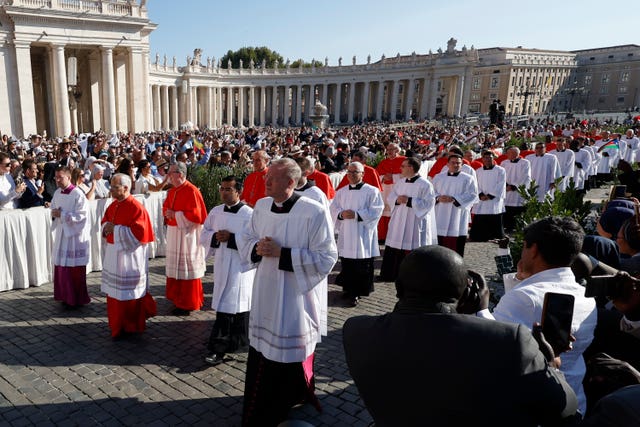Pope Francis has created 21 new cardinals in a ceremony including key figures at the Vatican and in the field who will help enact his reforms and cement his legacy with the Catholic Church.
On a crisp sunny morning filled with cheers from St Peter’s Square, Francis expanded his influence on the College of Cardinals who will help him govern and one day elect his successor. With Saturday’s additions, nearly three-quarters of the voting-age “princes of the church” owe their red hats to the Argentine Jesuit.
In his instructions to the new cardinals at the start of the service, Francis said their variety and geographic diversity would serve the church like musicians in an orchestra, where sometimes they play solos, sometimes as an ensemble.
“Diversity is necessary; it is indispensable. However, each sound must contribute to the common design,” he told them. “This is why mutual listening is essential – each musician must listen to the others.”
Among the new cardinals was the controversial new head of the Vatican’s doctrine office, Victor Manuel Fernandez, and the Chicago-born missionary now responsible for vetting bishop candidates around the globe, Robert Prevost.

Also entering the exclusive club were the Vatican’s ambassadors to the US and Italy, two important diplomatic posts where the Holy See has a keen interest in reforming the church hierarchy.
Leaders of the church in geopolitical hotspots like Hong Kong and Jerusalem, fragile communities like Juba and South Sudan, and sentimental favourites like Cordoba in Argentina, filled out the roster.
Francis’s promotions of Mr Prevost and his ambassador to Washington, French Cardinal Christophe Pierre, were clear signs that he has his eye on shifting the balance of power in the US hierarchy, where some conservative bishops have resisted his reforms. The pair are responsible for proposing new bishop candidates and overseeing investigations into problem ones already in place.
“I think I do have some insights into the church in the United States,” Mr Prevost said after the ceremony during a welcome reception in the Apostolic Palace. “So the need to be able to advise, work with Pope Francis and to look at the challenges that the church in the United States is facing, I hope to be able to respond to them with a healthy dialogue.”
The ceremony took place days before Francis opens a meeting of bishops and lay Catholics on charting the church’s future, where issues such as women’s roles in the church, LGBT+ Catholics and priestly celibacy are up for discussion.
The October 4-29 synod is the first of two sessions that in many ways could cement Francis’s legacy as he seeks to make the church a place where all are welcomed, where pastors listen to their flocks and accompany them rather than judge them.
Several of the new cardinals are voting members of the synod and have made clear they share Francis’s vision of a church that is more about the people in the pews than the hierarchy, and that creative change is necessary.
Among them is Mr Fernandez, known as the “pope’s theologian” and perhaps Francis’s most consequential Vatican appointment in his 10-year pontificate.

In his letter naming Mr Fernandez as prefect of the Dicastery for the Doctrine of the Faith, Francis made clear he wanted his fellow Argentine to oversee a radical break from the past, saying the former Holy Office often resorted to “immoral methods” to enforce its will.
Rather than condemn and judge, Francis said he wanted a doctrine office that guards the faith and gives people hope. He also made clear Mr Fernandez would not have to deal with sex abuse cases, saying the office’s discipline section could handle that dossier.
It was a much-debated decision given Mr Fernandez has admitted he made mistakes handling a case while he was bishop in La Plata, Argentina, and that the scale of the problem globally has long called for authoritative, high-ranking leadership.
On the eve of the consistory to make Mr Fernandez a cardinal, clergy abuse survivors including a La Plata victim rallied near the Vatican, calling on Francis to rescind the nomination.
“No bishop who has covered up child sex crimes and ignored and dismissed victims of clergy abuse in his diocese should be running the office that oversees, investigates and prosecutes clergy sex offenders from around the world, or be made a cardinal,” said Julieta Anazco, the La Plata survivor, according to a statement from the End Clergy Abuse.
With Saturday’s ceremony, Francis will have named 99 of the 137 cardinals who are under the age of 80 and thus eligible to vote in a future conclave to elect his successor. While not all are proteges of the 86-year-old reigning pontiff, many share Francis’s pastoral emphasis as opposed to the doctrine-minded cardinals often selected by John Paul II and Benedict XVI.
Such a huge proportion of Francis-nominated cardinals almost ensures that a future pope will either be one of his own cardinals or one who secured Franciscan cardinal votes to lead the church after he is gone, suggesting a continuity in priorities.
Europe still has the most voting-age cardinals with 52, followed by the Americas with 39 and Asia with 24.
The ceremony installing them followed a ritual in which each man takes an oath to obey the Pope, remain faithful to Christ and serve the church. Francis reminded them that they were wearing red as a sign that they must be strong “even to the shedding of blood” to spread the faith.




Comments: Our rules
We want our comments to be a lively and valuable part of our community - a place where readers can debate and engage with the most important local issues. The ability to comment on our stories is a privilege, not a right, however, and that privilege may be withdrawn if it is abused or misused.
Please report any comments that break our rules.
Read the rules hereLast Updated:
Report this comment Cancel